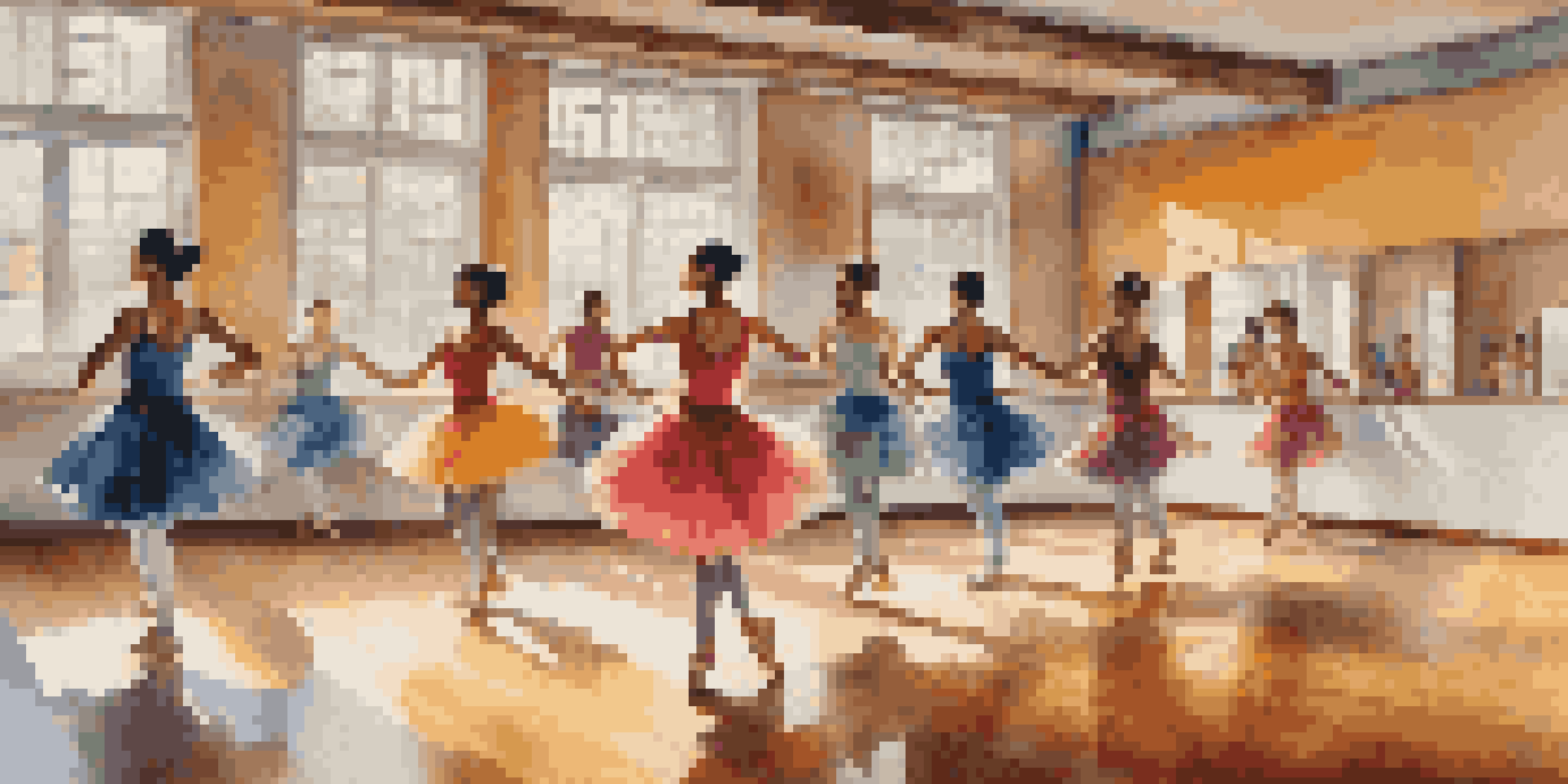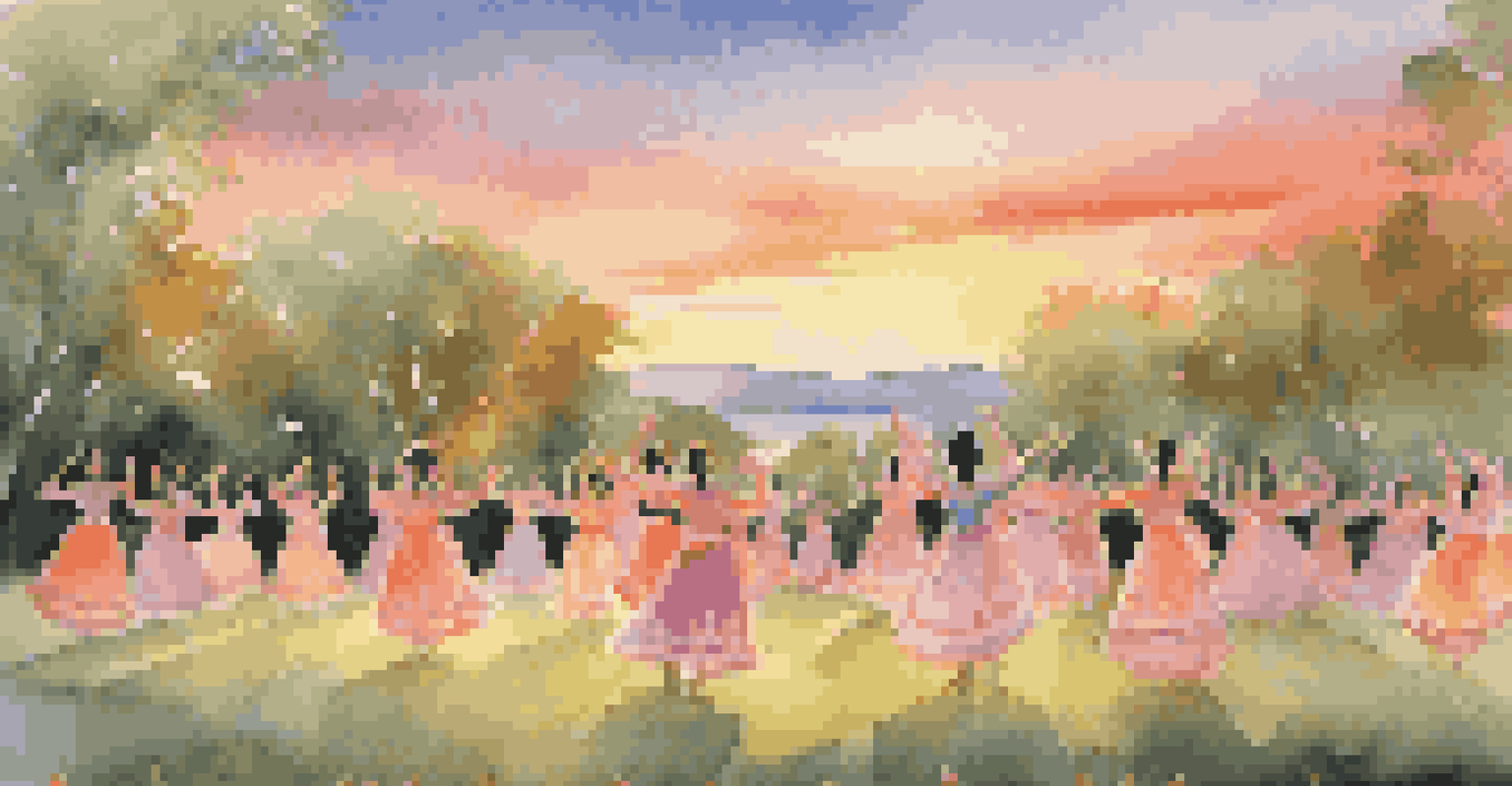The Significance of Documentation in Dance History

Understanding Dance Documentation and Its Purpose
Dance documentation refers to the methods used to record and preserve dance performances, choreography, and related materials. This can include video recordings, written scores, photographs, and even oral histories. The primary purpose of documentation is to create a permanent record that can be studied and appreciated by future generations.
Dance is the hidden language of the soul.
Without proper documentation, many dance forms risk being lost to time, as they are often transient by nature. For instance, a live performance can only be experienced once, but a well-documented piece allows others to engage with it later. This preservation not only honors the art form but also provides a valuable resource for educators, performers, and historians.
Furthermore, documentation serves as a bridge between different cultures and eras, enabling us to understand the evolution of dance. It reveals how dances have adapted over time, reflecting societal changes and cultural influences. By studying these records, we gain insight into the artistic choices of the past and their significance.
The Role of Documentation in Dance Education
In dance education, documentation plays a crucial role in teaching and learning. Teachers often rely on videos and written materials to convey choreography and technique to their students. These resources make it easier for learners to grasp complex movements and styles, fostering a deeper understanding of the art form.

Moreover, documented performances can serve as powerful case studies, allowing students to analyze and critique various techniques and interpretations. For example, watching a legendary dancer's performance can inspire students to explore their own creativity and develop their unique style. This aspect of documentation greatly enriches the learning experience.
Importance of Dance Documentation
Dance documentation preserves performances and techniques, ensuring that art forms are not lost to time.
Additionally, documentation aids in curriculum development by providing a historical context for various dance forms. Educators can trace the lineage of specific styles and help students appreciate their origins. This knowledge not only enhances students' skills but also instills a greater respect for the traditions and innovations in dance.
Preserving Cultural Heritage Through Dance Documentation
Dance is often a reflection of cultural identity, and documentation plays a key role in preserving this heritage. By recording traditional dances, communities ensure that their unique stories and practices are not forgotten. This process allows future generations to connect with their roots and maintain a sense of belonging.
The dance is a poem of which each movement is a word.
For instance, many indigenous communities use documentation to safeguard their traditional dances, which are often tied to rituals and celebrations. These records serve as vital resources for cultural revival efforts, helping to keep the spirit of these dances alive. Documentation empowers communities to reclaim and share their heritage with pride.
In a globalized world, where cultural exchanges are commonplace, dance documentation also fosters understanding and appreciation among diverse audiences. By showcasing different dance forms through documentation, we can celebrate the richness of global cultures. This exchange promotes respect and collaboration between communities, enriching the dance landscape as a whole.
The Impact of Technology on Dance Documentation
Advancements in technology have significantly transformed how dance is documented. High-definition video cameras, digital editing software, and online platforms make it easier than ever to record, edit, and share performances. This accessibility has democratized dance documentation, allowing more artists to showcase their work.
Social media has also played a pivotal role in dance documentation, enabling dancers and choreographers to reach wider audiences. Platforms like Instagram and TikTok allow performers to share short snippets of their work, capturing the essence of their art in real-time. This trend has created a new form of dance documentation that is immediate and engaging.
Role in Education and Research
Documented materials enhance dance education and academic research, providing valuable resources for learning and analysis.
However, while technology offers exciting opportunities, it also presents challenges. The sheer volume of content can make it difficult for significant works to stand out. As we embrace these new tools, it's essential to strike a balance between quantity and quality, ensuring that important contributions to dance history are not overlooked.
The Challenge of Documenting Ephemeral Art Forms
One of the most significant challenges in dance documentation is the ephemeral nature of the art form itself. Unlike visual arts, which can be preserved as physical objects, dance happens in a fleeting moment. This transient quality makes it essential to capture the essence of a performance before it disappears.
Choreographers often face the dilemma of how to convey their vision when documenting a piece. They must decide what elements are crucial to preserving the work's integrity and emotional impact. This process can become even more complex when considering the interpretive nature of dance, where each performance may differ slightly from the last.
To address these challenges, many dance artists and historians are developing new strategies for documentation. This includes creating detailed written accounts, using various camera angles in recordings, and incorporating audience reactions. By embracing innovative approaches, we can better capture the richness of dance and ensure that it continues to inspire future generations.
Documenting Dance for Research and Scholarship
Academic research plays a vital role in advancing our understanding of dance, and documentation is essential for this process. Scholars rely on documented materials to analyze various aspects of dance, from its historical context to its cultural significance. This research helps to fill gaps in dance history and brings new insights to light.
For example, a researcher studying a specific dance style may examine video recordings, interviews with practitioners, and written critiques. These various sources create a comprehensive picture of the dance form, allowing scholars to explore its evolution and impact. Such research not only enriches the academic discourse but also informs contemporary practice.
Technology's Impact on Documentation
Advancements in technology have transformed dance documentation, making it more accessible while also presenting new challenges.
Moreover, documentation facilitates interdisciplinary collaborations between dance and other fields, such as anthropology, sociology, and psychology. By examining dance through multiple lenses, researchers can uncover deeper meanings and connections. This holistic approach ultimately enhances our appreciation of dance as a multifaceted art form.
The Future of Dance Documentation: Trends and Innovations
As we look to the future, the landscape of dance documentation continues to evolve. Emerging technologies, such as virtual reality and artificial intelligence, are opening new possibilities for how we capture and experience dance. These innovations promise to create immersive experiences that allow audiences to engage with dance in unprecedented ways.
For instance, virtual reality can transport viewers into the midst of a performance, offering a front-row seat to the action. This level of engagement can deepen our understanding of the art form and make it more accessible to diverse audiences. Such advancements could also pave the way for interactive documentation, where viewers can explore different aspects of a performance at their own pace.

However, as we embrace these new technologies, it’s essential to remain grounded in the core values of dance documentation: authenticity, preservation, and cultural respect. By keeping these principles at the forefront, we can ensure that the future of dance documentation remains true to the art form's spirit while embracing innovation.